Table of Contents
- Introduction
- Editor’s Choice
- Quantum Computing Statistics by Market Size
- Global Quantum Computing Market – Segment Revenue
- Quantum Computing Usage Across Several Sectors
- Quantum Computing Hardware
- 20 Years of Quantum Computing Growth
- Quantum Computing Statistics by Funding
- Fundings of Startups By Quantum Computing Statistics
- Quantum Computing Jobs Data
- Methods Used By Organizations For Preparation
- Considerations and Challenges in Quantum Computing Statistics
- Recent Developments
- Conclusion
- FAQs
Introduction
Quantum Computing Statistics: Quantum computing, is rooted in the principles of quantum mechanics. Employs quantum bits (qubits) that can exist in superposition (representing both 0 and 1 simultaneously) and be entangled.
Enabling them to perform complex calculations using quantum gates and algorithms. Notably, quantum computers have the potential to outpace classical counterparts in specific tasks, known as quantum supremacy.
With applications spanning cryptography, optimization, drug discovery, and fundamental physics simulations.
However, the field faces significant challenges, including error correction and practical implementation. As it progresses toward unlocking the full scope of its transformative capabilities.
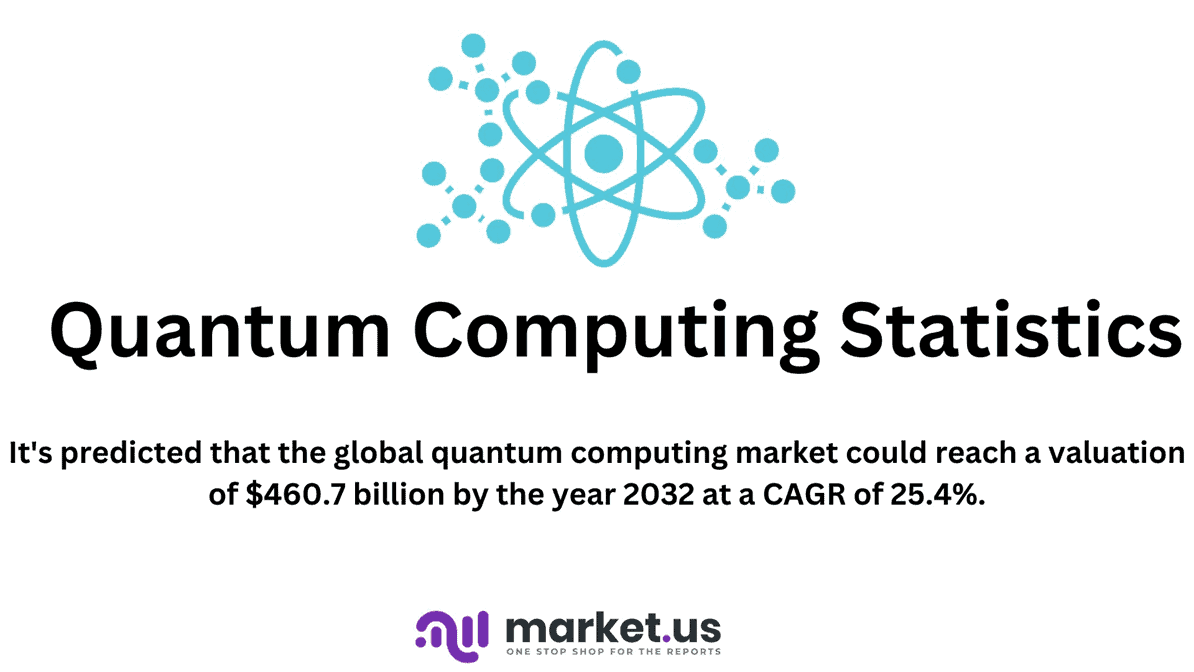
Editor’s Choice
- The D-Wave 2000Q quantum computer operates at a remarkably low temperature of just 0.015 Kelvin.
- 1Qbit stands as the pioneer in dedicated quantum computing.
- The anticipation is that quantum tunneling will significantly reduce power consumption, potentially 100 to 1000 times less.
- Up to now, five companies have ventured into producing quantum chips.
- It’s predicted that the global quantum computing market could reach a valuation of $460.7 billion by the year 2032.
- Looking ahead to 2030, the worldwide count of quantum computers might fall between 2,000 and 5,000 units.
- The Sa 30 qubit quantum computer can perform trillions of operations per second.
- In 2018, the quantum computing industry saw the emergence of 90 fresh job postings for commercial roles.
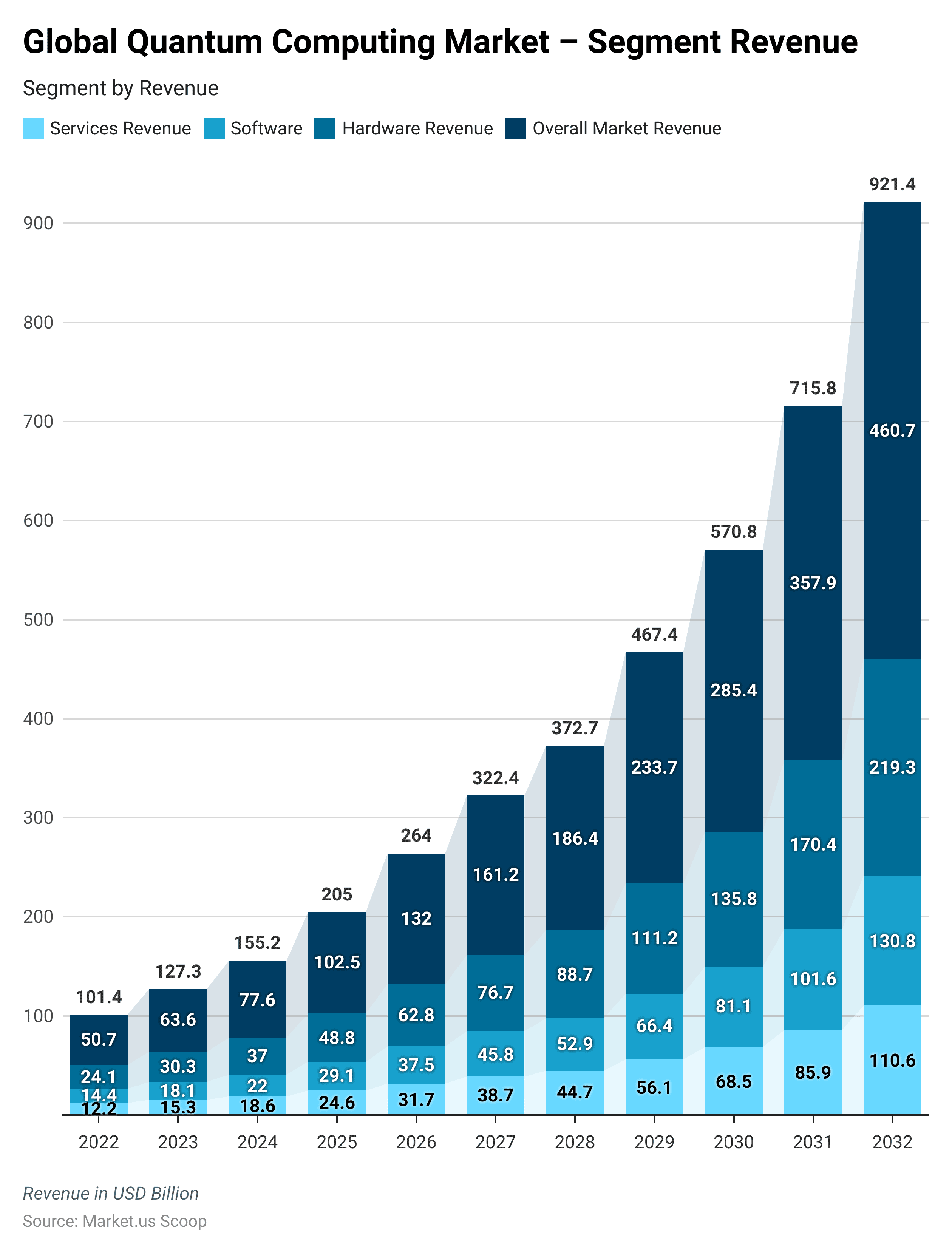
Quantum Computing Statistics by Market Size
- The quantum computing market is experiencing remarkable growth at a CAGR of 25.4%. With revenues projected to surge in the coming years.
- In 2022, the market was valued at 50.7 billion USD, and this figure is expected to rise to 63.6 billion USD in 2023, demonstrating a steady upward trajectory.
- The subsequent years forecast even more substantial growth. With revenues of 77.6 billion USD in 2024 and 102.5 billion USD in 2025, indicating a significant acceleration.
- As we look further ahead, the quantum computing market is poised to reach 132 billion USD in 2026 and 161.2 billion USD in 2027.
- The growth continues unabated, with projections of 186.4 billion USD in 2028 and 233.7 billion USD in 2029.
- By 2030, the market is anticipated to surpass the 285.4 billion USD mark, and the trend shows no signs of slowing down. With expectations of reaching 357.9 billion USD in 2031 and a substantial 460.7 billion USD in 2032.
- These projections underscore the burgeoning significance and potential of quantum computing in various industries.
(Source: Market.us)
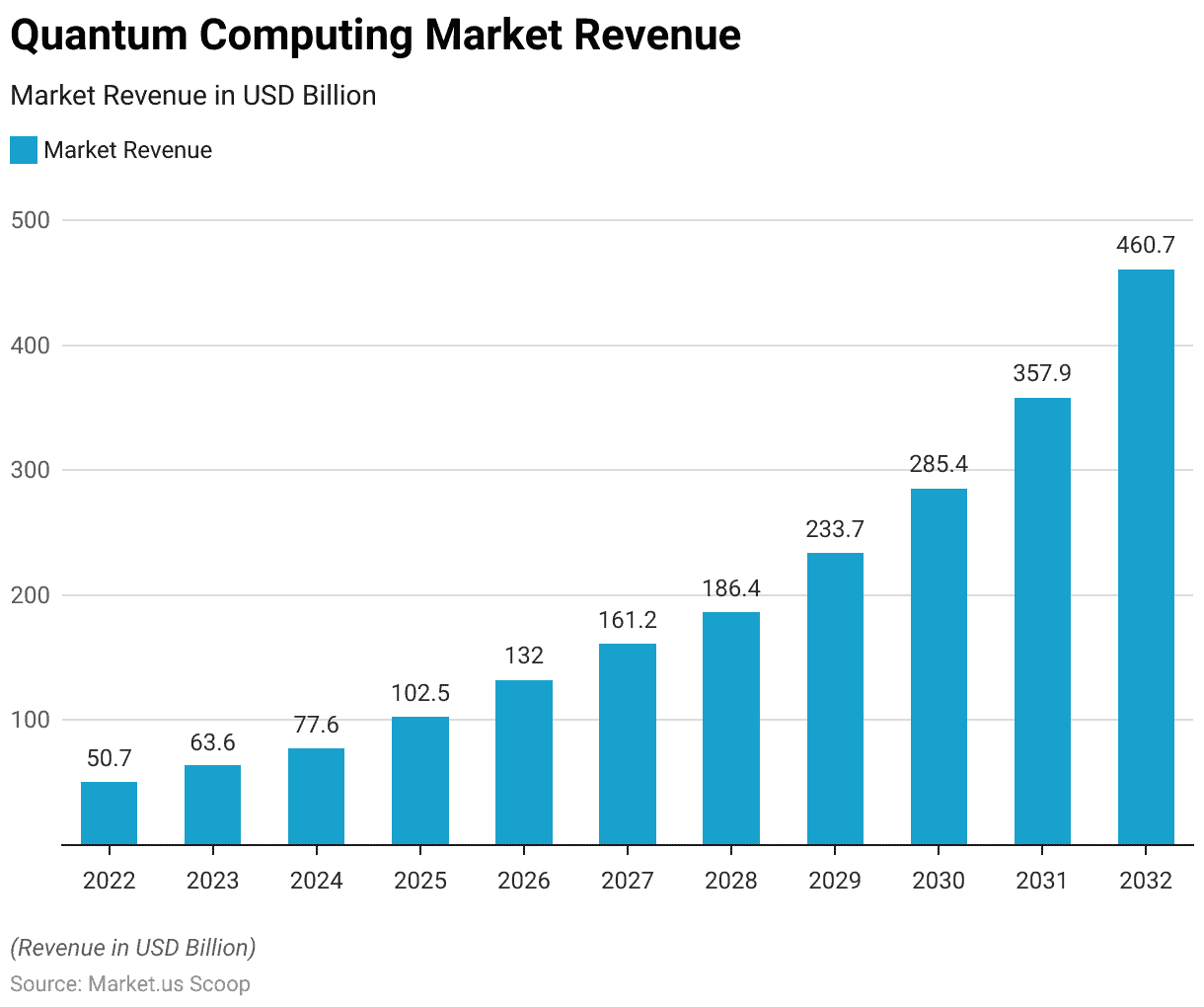
Global Quantum Computing Market – Segment Revenue
- The quantum computing market is poised for significant expansion across multiple facets. In 2022, the overall market revenue reached 50.7 billion USD. With hardware contributing 24.1 billion USD, software at 14.4 billion USD, and services accounting for 12.2 billion USD.
- As we progress to 2023, the market is set to grow to 63.6 billion USD. With hardware, software, and services generating 30.3 billion USD, 18.1 billion USD, and 15.3 billion USD, respectively.
- The trend continues, with projections indicating overall market revenues of 77.6 billion USD in 2024, driven by hardware revenue of 37 billion USD, software at 22 billion USD, and services generating 18.6 billion USD.
- Looking further into the future, 2025 is expected to see a quantum computing market worth 102.5 billion USD. With hardware, software, and services contributing 48.8 billion USD, 29.1 billion USD, and 24.6 billion USD, respectively.
- The subsequent years show sustained growth, culminating in a substantial overall market revenue of 460.7 billion USD in 2032. Fueled by hardware revenue of 219.3 billion USD, software at 130.8 billion USD, and services generating 110.6 billion USD. These projections underscore the increasing importance and diversification of the quantum computing market, encompassing hardware, software, and services.
(Source: Market.us)
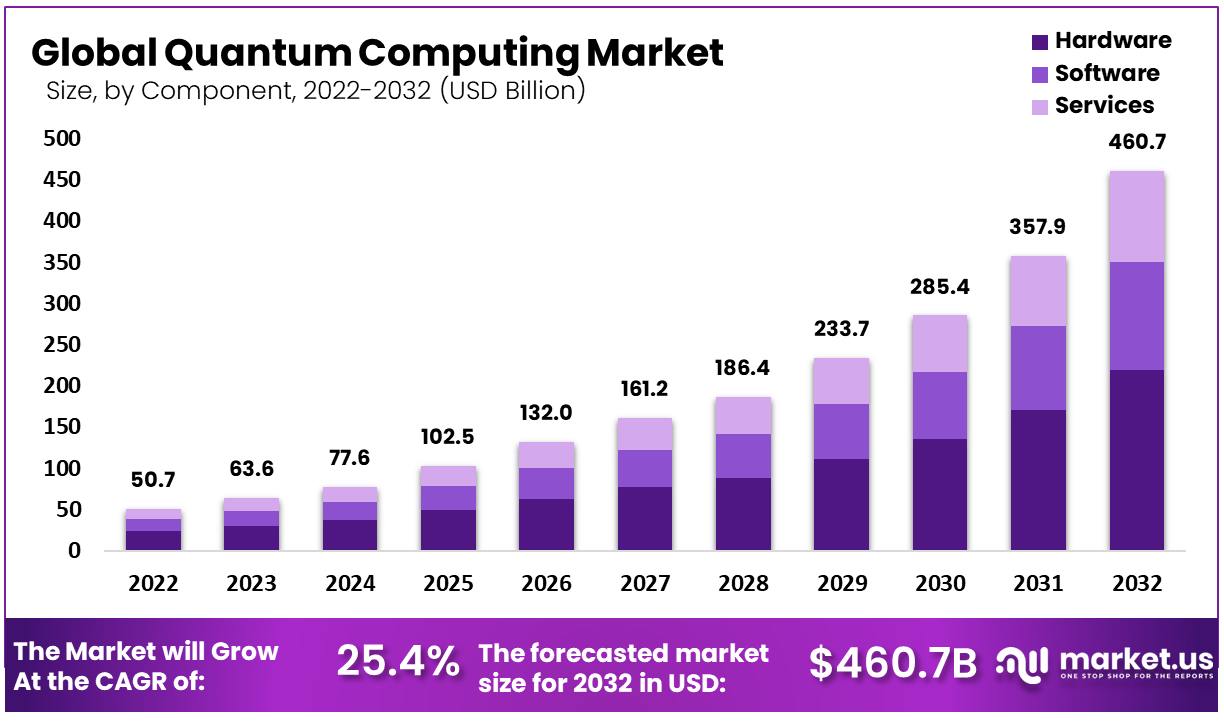
Quantum Computing Usage Across Several Sectors
- Quantum computing is making significant inroads into various sectors, with its usage steadily expanding across industries.
- Quantum computing is at the forefront of finance, with a substantial 28% adoption rate.
- The global energy and materials industry follows closely, with 16% utilization, leveraging quantum capabilities to address complex challenges.
- Advanced industries, including manufacturing and technology, harness quantum computing at 11%.
- Pharmaceuticals and healthcare are also benefiting, with 9% each, promising advancements in drug discovery and healthcare system optimization.
- In telecom, media, and professional services, quantum computing is making a notable impact, with a combined 16% adoption.
- Travel logistics and insurance integrate quantum computing at 4% and 6%, respectively, streamlining operations and risk assessment.
- Finally, the consumer goods sector is exploring the potential of quantum computing, which is currently at 3% utilization. This widespread adoption signifies the diverse applications and potential transformative effects of quantum computing across various sectors.
(Source: Market Splash)
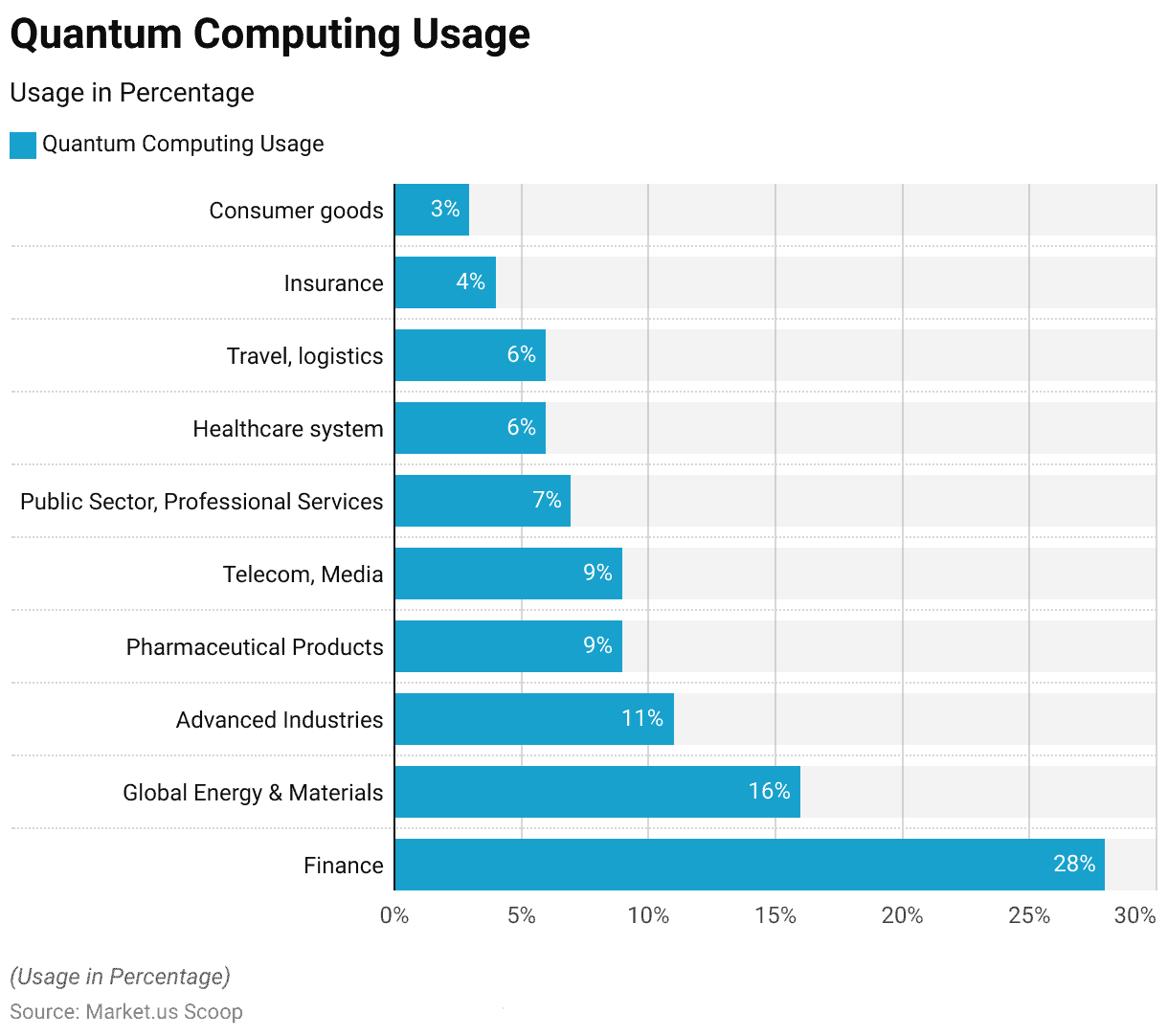
Quantum Computing Hardware
Quantum Computing Statistics by Memory
- Trapped ions have shown promise in achieving quantum memory lifetimes lasting over 30 minutes, a significant breakthrough.
- Furthermore, they’ve achieved low error rates, with fewer than 10-3 errors per entanglement swapping operation, a critical factor for efficient quantum repeaters.
- However, the remaining challenge lies in effectively connecting these ions to telecom photons to establish entanglement between repeater stations separated by approximately 30 km.
- By achieving efficient ion-photon coupling within a compact, high-quality fiber cavity, manufacturers aim to eventually enable entanglement distribution across terrestrial distances spanning thousands of kilometers while maintaining entanglement for extended periods, potentially in the tens of minutes.
(Source: National Institute of Standards & Technology)
Quantum Computing Statistics by Processors
- Alpine Quantum Technologies introduced the PINE System in June 2021, utilizing trapped ion technology and boasting 24 qubits.
- Atom Computing’s Phoenix, relying on neutral atoms in optical lattices, stood out with perfect fidelity at 100% and was released in August 2021.
- A significant player in the field, Google entered the quantum arena in 2017 with a 20-qubit superconducting system, followed by a planned 49-qubit system in Q4 2017, showcasing exceptional fidelity above 99%.
- Google’s Bristlecone, featuring a 72-qubit superconducting transmon design with high fidelity across multiple qubits, was unveiled on March 5, 2018.
- Google’s Sycamore, introduced in 2019, is another notable addition, boasting 53 practical qubits within a 9×6 lattice structure.
- D-Wave, a prominent manufacturer in annealing quantum processors, has developed a series of QPUs (Quantum Processing Units) known for their quantum annealing capabilities, distinct from digital annealing.
- This lineup began with the D-Wave One, codenamed Rainier, which was introduced on May 11, 2011.
- The D-Wave One employed a superconducting architecture and featured a Chimera layout of 4×4 K4,4 qubits, offering 128 qubits.
- Building on this foundation, D-Wave released the D-Wave Two in 2013, featuring the C8 architecture with an 8×8 K4,4 qubit layout and a significantly expanded qubit count of 512.
- Subsequent iterations included the D-Wave 2X in 2015, boasting a C12 architecture with a 12×12 K4,4 qubit arrangement, providing 1152 qubits.
- In 2017, D-Wave introduced the D-Wave 2000Q, incorporating the C16 architecture with a 16×16 K4,4 qubit configuration, offering 2048 qubits.
- Most recently, in 2020, D-Wave unveiled the D-Wave Advantage, featuring the Pegasus P16 architecture and a remarkable 5760 qubits.
(Source: Wikiwand)
20 Years of Quantum Computing Growth
- Quantum computing has seen significant progress, with various organizations and institutions contributing to developing quantum computing systems.
- In 1998, a consortium of IBM, Oxford, Berkeley, Stanford, and MIT introduced an early system with two qubits.
- The year 2000 witnessed advancements, as the Technical University of Munich unveiled a 5-qubit system, while the Los Alamos National Laboratory introduced a 7-qubit system.
- Subsequent developments took place in 2006 when the Institute for Quantum Computing, Perimeter Institute for Theoretical Physics, and MIT jointly launched a 12-qubit system.
- D-Wave Systems made a substantial leap in 2008 with a 28-qubit quantum computer.
- In 2017, the IBM, Oxford, Berkeley, Stanford, and MIT consortium re-entered the scene with a 50-qubit system.
- The following year, in 2018, Intel made its mark with a 49-qubit system, while Google surged ahead with a 72-qubit system.
- Rigetti rounded off this timeline in 2019, unveiling an impressive 128-qubit quantum computing system. These milestones underscore the dynamic evolution and increasingly powerful capabilities of quantum computing systems.
(Source: Statista)
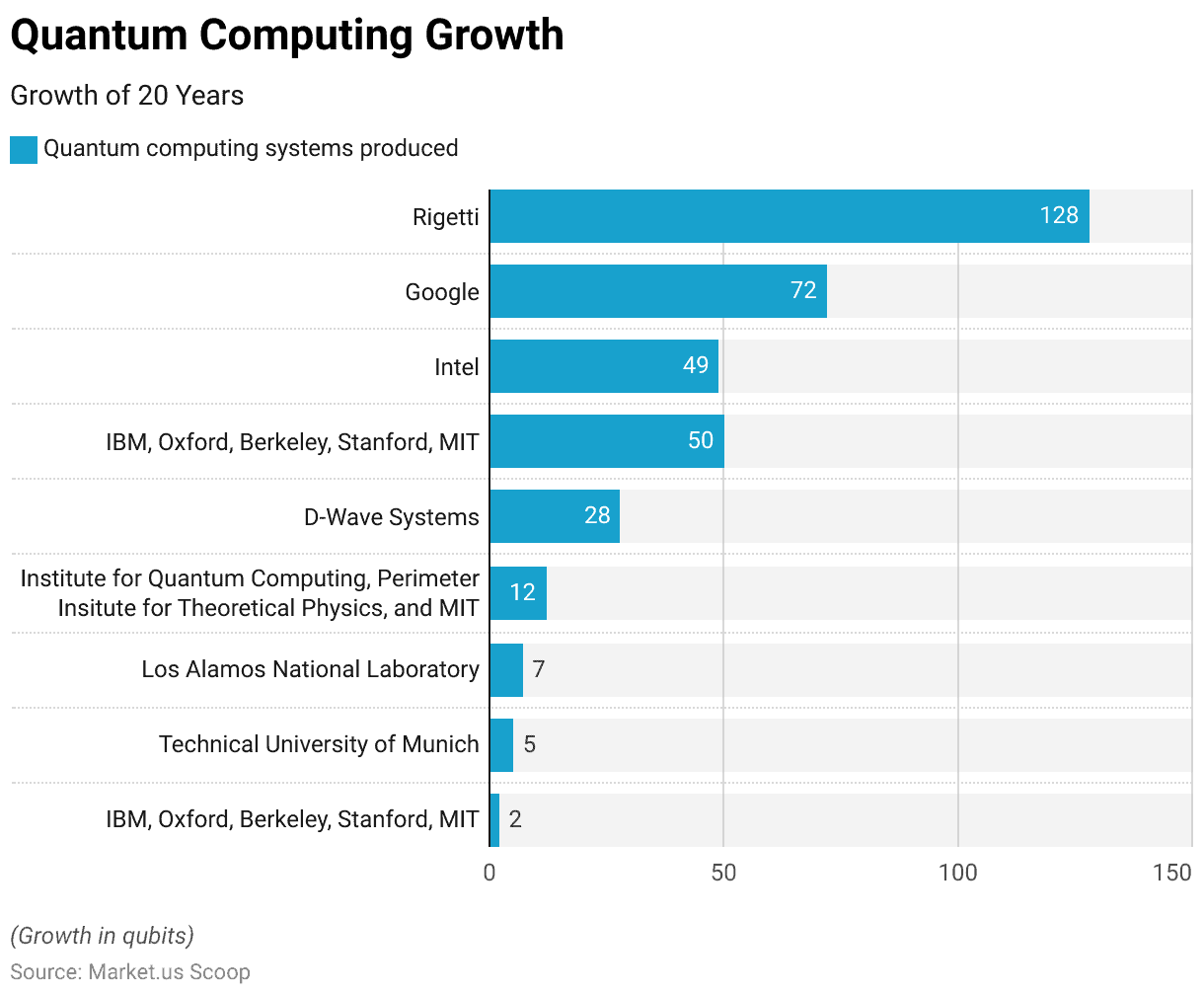
Quantum Computing Statistics by Funding
- Over the past six years, quantum computing has seen a fluctuating yet overall upward trend in funding and deal count. 2015, the sector secured $73 million in funding across six deals.
- The following year, in 2016, funding decreased to $39 million but saw an increase in deal count to 10.
- However, 2017 marked a significant turning point as quantum computing attracted $287 million in funding through 13 deals.
- This momentum continued into 2018 with $116 million across 23 deals.
- The year 2019 was particularly robust, with a remarkable $417 million in funding distributed among 26 deals.
- In 2020, despite the global challenges posed by the pandemic, quantum computing remained resilient, securing $365 million across 37 deals. These figures reflect the growing interest and investment in the quantum computing sector.
(Source: CB Insights)
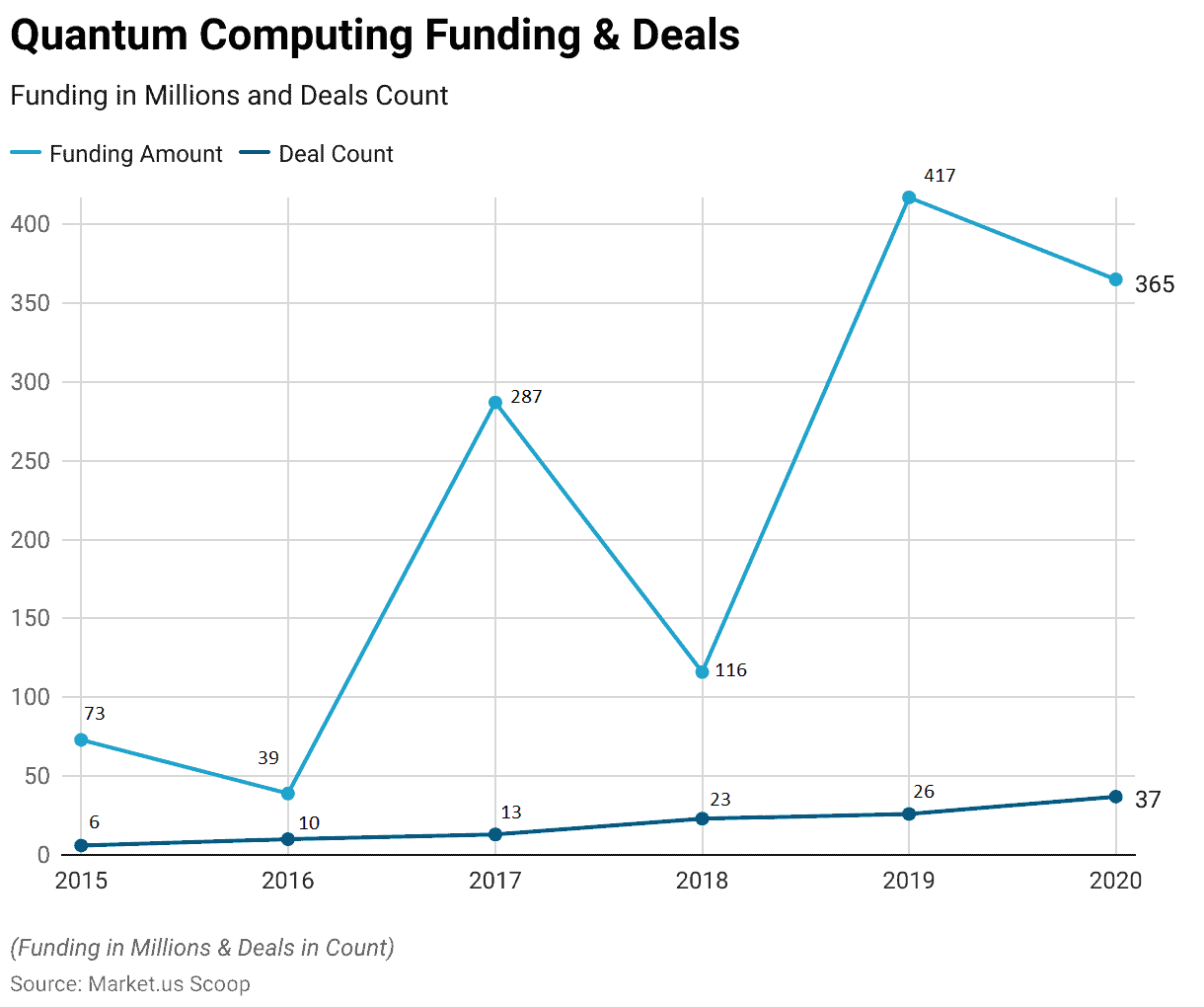
Fundings of Startups By Quantum Computing Statistics
- Startups and organizations in the quantum computing arena have secured significant funding to advance their research and technologies.
- Leading the pack is D-Wave, which has raised an impressive $216 million across 19 funding rounds.
- Not far behind, Rigetti Computing has garnered substantial support, accumulating $198.5 million through 9 funding rounds.
- The University of Oxford in the UK, a hub for quantum research, has received a notable $117.59 million in grants to bolster its quantum endeavors.
- IonQ, with three funding rounds, has secured $52 million in funding.
- Silicon Quantum Computing has also made strides with a funding infusion of $66 million.
- Cambridge Quantum Computing (CQC) has seen substantial backing, raising $48 million across seven funding rounds.
- 1QBit, based in Canada, has secured CA$45 million through 4 funding rounds, and IQM, headquartered in Europe, has accumulated €29 million across three rounds. These funding figures underscore the growing financial support for quantum computing ventures, reflecting the increasing interest and investment in this transformative field.
(Source: Market Splash)
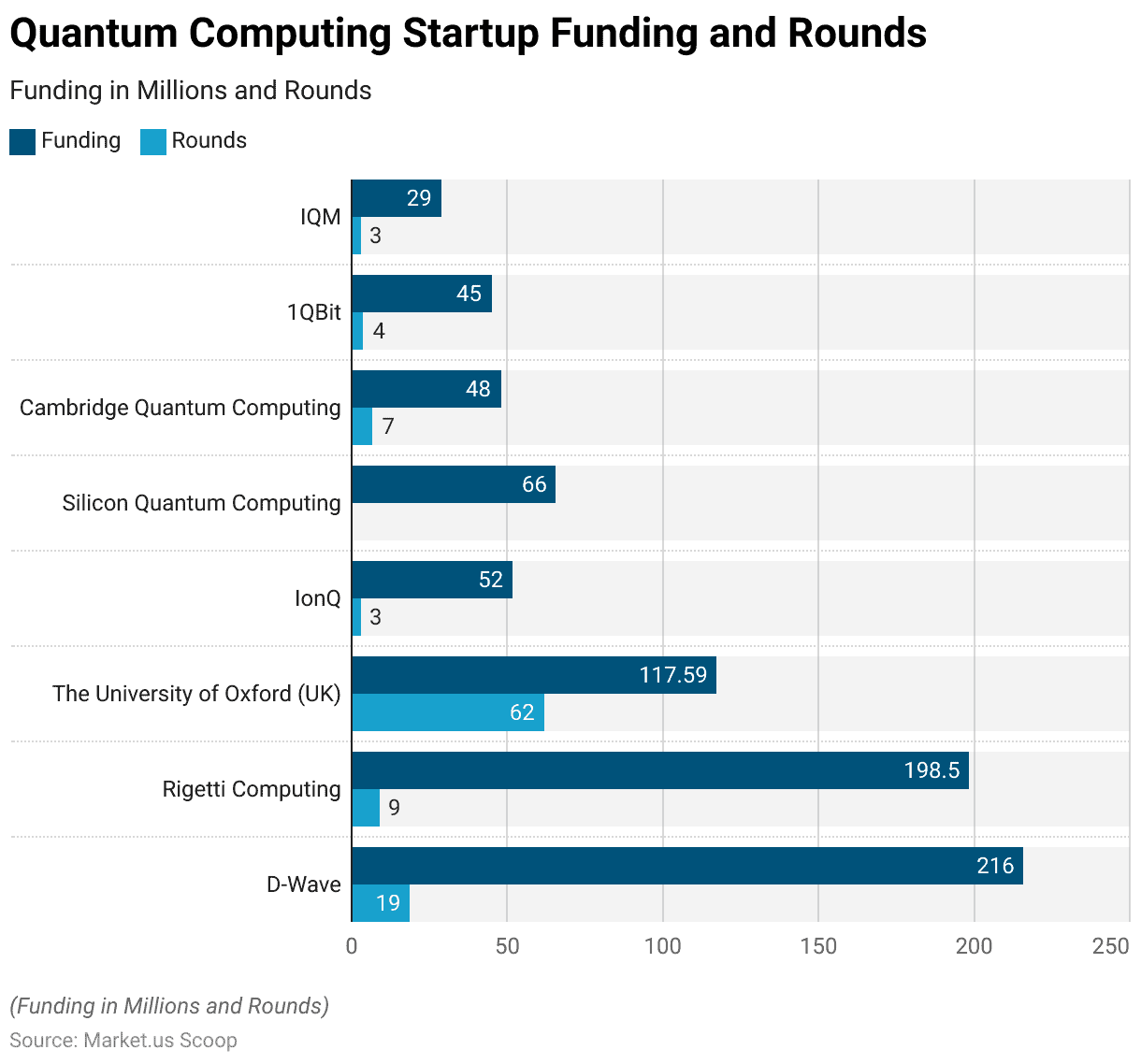
Quantum Computing Jobs Data
- The US Bureau of Labor Statistics lumps quantum computer research scientists with physicists in collecting data.
- In 2015, the total number of employed physicists stood at 15,650.
- Regarding employment trends, there was a remarkable uptick in job postings related to quantum computing in the commercial sector.
- In July 2018, the number of new job openings reached 188, significantly increasing from the 45 openings recorded in October 2017. These statistics underline a substantial growth in job prospects within quantum computing in recent years.
(Source: US Bureau of Labor Statistics)
Methods Used By Organizations For Preparation
- Organizations are employing diverse strategies to prepare for the adoption of quantum computing.
- On average, more than half of the surveyed organizations are assembling an in-house team.
- Other prevalent preparation methods encompass conducting experiments and constructing proof-of-concept projects, running experiments on quantum hardware or simulators, developing new applications, and collaborating with external vendors.
- Building an internal team is the favored approach among those at the initial stages of adoption while experimenting and creating proofs of concept are more commonly embraced by those in the planning phase of quantum computing adoption.
(Source: Statista)
Considerations and Challenges in Quantum Computing Statistics
- When selecting a quantum computing provider, most organizations are primarily concerned with accessibility and compatibility.
- Nearly half of the survey participants, totaling 48 percent, identified future compatibility as a significant consideration.
- Additional factors considered include credibility, quality, reputation, and the ability to integrate with existing systems seamlessly.
- Security-related issues emerged as the most prevalent challenge for organizations embracing quantum computing in 2022, with 44 percent of respondents highlighting this concern, marking a 6% increase from the previous year.
- The complexity of integrating quantum computing with their current IT infrastructure remained a substantial worry for 43 percent of organizations globally.
- Other obstacles included a shortage of expertise and talent and a lack of pre-existing advanced capabilities necessary for technology adoption.
(Source: Statista)
Recent Developments
Acquisitions and Mergers:
- IBM acquires Cambridge Quantum Computing: In early 2023, IBM completed its acquisition of Cambridge Quantum Computing for $300 million. This acquisition aims to strengthen IBM’s quantum computing capabilities and accelerate the development of quantum applications.
- Honeywell merges with Quantinuum: Honeywell’s quantum computing division merged with Cambridge Quantum Computing to form Quantinuum in late 2022. The merger aims to create a leading integrated quantum computing company.
New Product Launches:
- IBM’s Eagle Quantum Processor: IBM launched its new 127-qubit Eagle quantum processor in 2023, offering enhanced computational capabilities and marking a significant milestone in the development of quantum hardware.
- Google’s Sycamore 2.0: In mid-2023, Google introduced Sycamore 2.0, an upgraded version of its quantum processor, featuring improved error correction and increased qubit coherence times.
Funding:
- D-Wave raises $400 million: Quantum computing company D-Wave secured $400 million in a funding round in 2023 to expand its quantum computing platform and accelerate the development of quantum applications for businesses.
- Rigetti Computing raises $300 million: Rigetti Computing, a pioneer in hybrid quantum-classical computing, raised $300 million in early 2024 to enhance its quantum computing infrastructure and expand its cloud-based quantum services.
Technological Advancements:
- Quantum Supremacy Achieved: Google and IBM both claimed significant advancements toward quantum supremacy in 2023, with Google demonstrating a complex calculation on Sycamore 2.0 that surpassed classical computing capabilities.
- Improved Quantum Error Correction: Researchers have made significant progress in quantum error correction techniques, crucial for developing reliable and scalable quantum computers.
Market Dynamics:
- Growing Quantum Computing Market: The global quantum computing market is expected to grow at a CAGR of 30% from 2023 to 2030, driven by increasing investments in quantum research and the commercialization of quantum technologies.
- Adoption in Various Industries: Quantum computing is gaining traction in industries such as pharmaceuticals, finance, and logistics, with companies exploring its potential for solving complex optimization and simulation problems.
Regulatory and Strategic Developments:
- National Quantum Initiative Act: The US government continues to support quantum research through the National Quantum Initiative Act, allocating $1.2 billion in 2023 for quantum research and development.
- EU Quantum Flagship Program: The European Union’s Quantum Flagship program, with a budget of €1 billion, aims to advance quantum technologies and foster collaboration among European quantum research institutions.
Research and Development:
- Quantum Cryptography Advances: Significant progress is being made in quantum cryptography, with new protocols being developed to ensure secure communication channels resistant to quantum attacks.
- Quantum Materials Research: Researchers are exploring new materials, such as topological insulators and superconductors, to develop more efficient qubits and improve the performance of quantum processors.
Conclusion
Quantum Computing Statistics – The exploration of quantum computing underscores this field’s remarkable growth and transformative potential.
The quantum ecosystem thrives from the theoretical foundations of qubits, superposition, and entanglement to the rapid development of quantum hardware with increasing qubit counts and expanding quantum software libraries.
Applications across cryptography, material science, machine learning, finance, and drug discovery herald a new era of problem-solving capabilities.
Challenges like error correction and scalability remain, but emerging technologies and government recognition of quantum’s strategic importance point to a promising future.
Quantum computing is no longer a distant dream but a reality with profound implications, inviting us to reshape computation, security, and innovation on the cusp of a quantum revolution.
FAQs
Quantum computing is a cutting-edge computing paradigm that leverages the principles of quantum mechanics, such as superposition and entanglement, to perform complex computations at speeds unattainable by classical computers.
Qubits, short for quantum bits, are the fundamental units of quantum information. Unlike classical bits, which can be either 0 or 1, qubits can exist in a superposition of states, allowing them to represent both 0 and 1 simultaneously.
Quantum hardware has been rapidly advancing. As of September 2021, companies like IBM, Google, and others had developed quantum processors with tens to hundreds of qubits. Quantum volume metrics were often used to measure computational power, which had been steadily increasing. However, it’s important to note that the field evolves quickly, and the numbers may have changed significantly since then.
While quantum computing is still in its early stages, practical applications are emerging. These include quantum cryptography for secure communication, optimization problems in logistics and finance, and quantum machine learning algorithms for data analysis. Many of these applications are being actively researched and developed.
Quantum computing faces several challenges, including error correction to overcome decoherence, scalability to build more extensive and powerful quantum systems, and the standardization of hardware and software. Additionally, ethical and security considerations are a concern in a world with advanced quantum capabilities.
Discuss your needs with our analyst
Please share your requirements with more details so our analyst can check if they can solve your problem(s)



